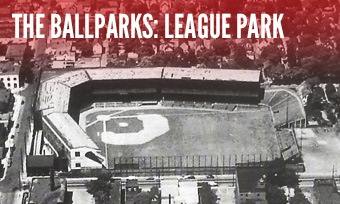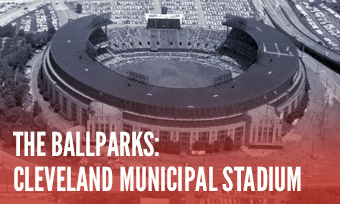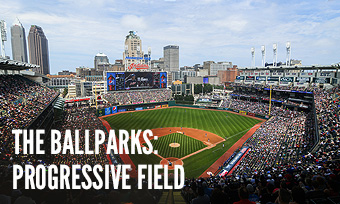THE TEAMS
Cleveland Guardians
Known as the Cleveland Blues, 1901-04; Cleveland Naps, 1905-14; Cleveland Indians, 1915-2021
THE GUARDIANS BY THE DECADE
The 1900s
Starting out as the Blues and then the Naps when it lucked into superlative hitter Nap Lajoie (who escaped Philadelphia after the Pennsylvania state court ordered him to return to the rival National League), Cleveland warmed up through the decade with top-notch hitting courtesy of Lajoie and Elmer Flick, and the brilliant pitching of Addie Joss—who tragically succumbed to tubercular meningitis in 1911. The franchise came closest to an American League pennant in 1908 when it finished a mere half-game behind first-place Detroit.
The 1910s
Lajoie faded and was dealt away after 1914—and the Naps became the Indians, it is said, in honor of Louis Sockalexis, the first Native American major leaguer. A change in branding did little to bolster a decade that was a mixed bag of more near-misses, a severe mid-decade funk and the presence of two genuine superstars: Joe Jackson and, shortly after his departure, Tris Speaker, who took over as player-manager in 1919 and presided over a brief rise to the top.
The 1920s
The decade began with an emotional 1920 season that saw the on-field death of popular shortstop Ray Chapman, a 31-win performance by Jim Bagby and the franchise’s first pennant and World Series triumph. The offense continued to roll behind Speaker, impossible-to-whiff Joe Sewell, Charlie Jamieson and George Burns, but a lack of talented pitching beyond the presence of George Uhle doomed Cleveland to the second division for the bulk of the period.
The 1930s
Outside of a 75-76 mark in 1933, Cleveland finished above .500 every year in the decade—but never finished closer than 12 games out of first place. Bouncing around between cozy League Park and cavernous Cleveland Stadium (which opened in 1932), the Indians continued to field strong offense behind a new wave of talent including Earl Averill and Hal Trosky, but it was pitcher Bob Feller who really turned heads in 1936 when he debuted for Cleveland as a 17-year old with a supersonic (yet sometimes erratic) fastball.
The 1940s
Cleveland became its own worst enemy in 1940 when a player mutiny (hardly the first in team history) torpedoed its own chances to take the AL pennant. Another maddening string of average results followed, but it finally all came together in 1948 under colorful owner Bill Veeck—whose endless, often outrageous promotional stunts shattered attendance records—as player-manager-MVP Lou Boudreau steered Cleveland past one Boston team (a one-game playoff victory over the Red Sox) to win the AL pennant, then another (the Braves) to snag its last World Series crown to date.
The 1950s
Behind a formidable rotation of Feller, Bob Lemon, Early Wynn and Mike Garcia, Cleveland constantly stayed in the hunt for more AL flags—but five second-place finishes in a six-year period, all to the New York Yankees, led to repeated frustration. It took Cleveland a then AL-record 111 wins in 1954 to outlast the Yankees, but the euphoria of the breakthrough was punctured when the team were swept by the New York Giants in the World Series. New ownership late in the decade unwisely cleaned out many of the key players on and off the field, sending Cleveland back to mediocrity.
The 1960s
Cleveland fans practically revolted in 1960 when beloved slugger Rocky Colavito was traded; the move set off a decade in which the Indians lacked serious star power at the plate with no threat to score—and thus, no threat to contend. That the team even stuck around the .500 mark was a tribute to the team’s staunch pitching, highlighted by Sam McDowell’s abundant strikeout totals and Luis Tiant’s exceptional 1.60 earned run average in 1968.
The 1970s
As the City of Cleveland decayed, so did the Indians, who settled into abysmal times to match the depressive state of their home. It all hit rock bottom in 1974 when the team inexplicably held Ten-Cent Beer Night at Cleveland Stadium, which resulted in a riot started by a surplus of drunkards. The decade’s few highlights included an excellent yet brief tenure for closet spitballer Gaylord Perry, the debut of Frank Robinson as the majors’ first black manager, and light-hitting shortstop Duane Kuiper’s one and only home run in 3,379 career at-bats.
The 1980s
The long-suffering plight of the woebegone Indians reached pop-cultural status when a Hollywood movie (Major League) dared to dream of Cleveland winning an AL pennant. Sports Illustrated truly believed the idea itself and picked Cleveland to reach the World Series in 1987; the team responded by losing 101 games. A quality offensive lineup (Joe Carter, Brett Butler, Julio Franco) did its best to give the team promise, but lousy pitching constantly derailed such aspirations.
The 1990s
The franchise (to say nothing of downtown Cleveland) came back to life with the 1994 opening of Jacobs Field—and soon after, Cleveland sold out 455 consecutive games to set a major league record (since broken by Boston). The return to prominence resulted in an impressive mix of homegrown stars (Albert Belle, Jim Thome, Manny Ramirez, Charles Nagy) and shipped-in veterans (Omar Vizquel, Roberto Alomar, Orel Hershiser) that surged Cleveland to five straight divisional titles and its first two pennants in over 40 years—though World Series triumph remained out of reach with losses to Atlanta in 1995 and Florida in 1997.
The 2000s
Owner Dick Jacobs, who oversaw the Indians’ rebirth, sold in 2000; under successor Larry Dolan, the collection of All-Star talent withered away, and fan support followed suit—with attendance dropping back below two million. Cleveland did enjoy one brief spike of success in mid-decade as sparkplug Grady Sizemore, slugger Travis Hafner and ace pitcher CC Sabathia took the team to the brink of an AL pennant in 2007—but blew a 3-1 ALCS lead against Boston. Otherwise, Cleveland regressed back to bottom-feeder status as small-minded ownership took on a decidedly different tact from Jacobs’ approach.
The 2010s
Cleveland’s roster evolved into a healthy mix of bright young talent and reborn cast-offs, but the results were largely uneven and underwhelming to preseason “experts” who regularly predicted the team to finish first. Then former Boston manager Terry Francona stepped in and maximized the optimism, as Cleveland went the rest of the decade without a losing record while reaching the postseason four times. Highlights included an AL pennant in 2016 (followed by a tough World Series loss to the Cubs) and an AL-record 22-game win streak in 2017—but these successes strangely weren’t enough to convince stubborn Cleveland fans from returning to the ballpark as the Indians constantly ranked near the bottom in MLB team attendance.
The 2020s
Bowing to increasing public pressure, the team in 2022 renamed itself the Guardians as a nod to the art deco pillars gracing the nearby Lorain-Carnegie Bridge. On the field, Cleveland remained competitive despite a young roster and low payroll, not skipping a beat in managership as Francona gave way to Stephen Vogt—who won AL Manager of the Year honors in each of his first two years. Perennial All-Star third baseman Jose Ramirez emerged as the team’s top offensive dog, while Emmanuel Clase established himself as MLB’s elite closer—before getting caught up in a troubling pitch-fixing scandal in 2025.
Highlights of the Guardians’ History on This Great Game:
 1910: A Carload of Trouble The World Series becomes anticlimactic following a strange and controversial ending to the individual batting race between two of baseball’s premier hitters: Cleveland’s Nap Lajoie and Detroit’s Ty Cobb.
1910: A Carload of Trouble The World Series becomes anticlimactic following a strange and controversial ending to the individual batting race between two of baseball’s premier hitters: Cleveland’s Nap Lajoie and Detroit’s Ty Cobb.
 1920: Saviors of the Game In a year where Babe Ruth becomes king and the game is rocked by the Black Sox Scandal, the Indians traverse through tragedy and triumph to record their first-ever world title.
1920: Saviors of the Game In a year where Babe Ruth becomes king and the game is rocked by the Black Sox Scandal, the Indians traverse through tragedy and triumph to record their first-ever world title.
 1948: The Greatest Show in Cleveland Bill Veeck, the maverick owner of the Cleveland Indians, brings ’em through the gates with memorable attractions on and off the field.
1948: The Greatest Show in Cleveland Bill Veeck, the maverick owner of the Cleveland Indians, brings ’em through the gates with memorable attractions on and off the field.
 1954: At Least They Stopped the Yanks The Indians go titanic and put a halt to the New York Yankees’ five-year American League reign—but they fall short of a world title in October.
1954: At Least They Stopped the Yanks The Indians go titanic and put a halt to the New York Yankees’ five-year American League reign—but they fall short of a world title in October.
 1994: The Year That Should’ve Been A bitter and vastly unpopular player strike shuts down the season in August—and with it brings a cruel end to the Indians’ first serious run at the postseason in 40 years.
1994: The Year That Should’ve Been A bitter and vastly unpopular player strike shuts down the season in August—and with it brings a cruel end to the Indians’ first serious run at the postseason in 40 years.
 1997: A Blockbuster of a Binge The Indians try again to capture a long-sought championship for Cleveland, matching up in the World Series against a Florida Marlin team fueled by a reckless spending spree.
1997: A Blockbuster of a Binge The Indians try again to capture a long-sought championship for Cleveland, matching up in the World Series against a Florida Marlin team fueled by a reckless spending spree.






